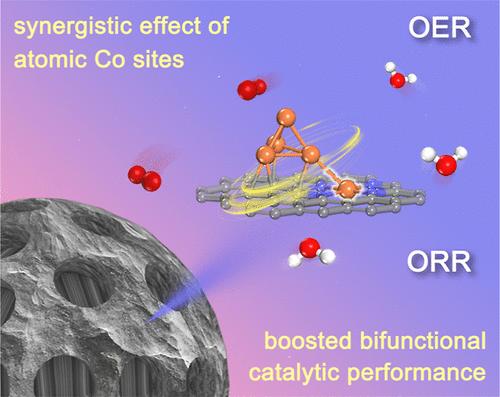高效氧电催化中钴低核簇和单核位点协同作用诱导的电子结构调制
IF 16
1区 材料科学
Q1 CHEMISTRY, MULTIDISCIPLINARY
引用次数: 0
摘要
用于锌-空气电池等应用的高性能双功能单原子催化剂的开发受到轻度氧还原和进化反应(ORR和OER)的极大阻碍。在此,我们报告了一种双功能氧电催化剂,旨在克服这些限制。该催化剂由分散良好的低核Co簇和相邻的Co单原子组成,并覆盖在氮掺杂碳基体(CoSA+C/NC)上。通过这些Co之间的强电子相互作用,实现了精确定制的不对称电子结构。Co簇优化了氧合中间体在单原子Co位点上的吸附/解吸强度,在碱性条件下具有0.91 V的半波电位(E1/2)和340 mV的过电位(η)。此外,CoSA+C/NC组装的锌空气电池具有284.1 mW cm-2的高功率密度和400 h的工作寿命,优于基准Pt/C + RuO2。实验结果和理论分析表明,双功能活性的增强源于Co簇与单原子Co位之间的协同相互作用。因此,*OH的过结合随着*OH的加速去除而被抑制。本工作建立了具有强电子相互作用的多相金属的先进电催化剂的设计原则。本文章由计算机程序翻译,如有差异,请以英文原文为准。

Electronic Structure Modulation Induced by the Synergy of Cobalt Low-Nuclearity Clusters and Mononuclear Sites for Efficient Oxygen Electrocatalysis
The development of high-performance bifunctional single-atom catalysts for use in applications, such as zinc–air batteries, is greatly impeded by mild oxygen reduction and evolution reactions (ORR and OER). Herein, we report a bifunctional oxygen electrocatalyst designed to overcome these limitations. The catalyst consists of well-dispersed low-nuclearity Co clusters and adjacent Co single atoms over a nitrogen-doped carbon matrix (CoSA+C/NC). The precisely tailored asymmetric electronic structures are achieved with strong electronic interactions between these Co species. The Co clusters optimize the adsorption/desorption strength of oxygenated intermediates on single-atomic Co sites to endow exceptional activity under alkaline conditions with a half-wave potential (E1/2) of 0.91 V and an overpotential (η) of 340 mV at 10 mA cm–2. In addition, a zinc–air battery assembled with CoSA+C/NC achieves a high power density of 284.1 mW cm–2 and a long operational lifespan of 400 h, superior to those of the benchmark Pt/C + RuO2. Experimental findings and theoretical analysis reveal that the enhanced bifunctional activity stems from the synergistic interactions between Co clusters and single-atomic Co sites. Consequently, the overbinding of *OH is suppressed with accelerated *OH removal. This work establishes the design principle of advanced electrocatalysts with multiphase metal species bearing strong electronic interactions.
求助全文
通过发布文献求助,成功后即可免费获取论文全文。
去求助
来源期刊

ACS Nano
工程技术-材料科学:综合
CiteScore
26.00
自引率
4.10%
发文量
1627
审稿时长
1.7 months
期刊介绍:
ACS Nano, published monthly, serves as an international forum for comprehensive articles on nanoscience and nanotechnology research at the intersections of chemistry, biology, materials science, physics, and engineering. The journal fosters communication among scientists in these communities, facilitating collaboration, new research opportunities, and advancements through discoveries. ACS Nano covers synthesis, assembly, characterization, theory, and simulation of nanostructures, nanobiotechnology, nanofabrication, methods and tools for nanoscience and nanotechnology, and self- and directed-assembly. Alongside original research articles, it offers thorough reviews, perspectives on cutting-edge research, and discussions envisioning the future of nanoscience and nanotechnology.
 求助内容:
求助内容: 应助结果提醒方式:
应助结果提醒方式:


